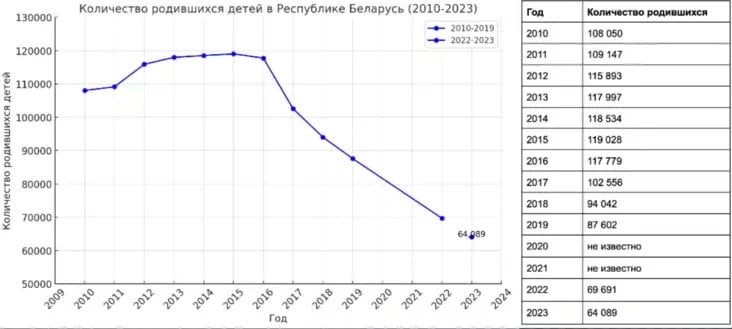Health Ministry’s Classified Report Confirms Demographic Catastrophe In Belarus
29- 30.10.2024, 12:35
- 13,002

There has never been such a low birth rate in Belarus.
Up-to-date data on birth rates (as well as mortality) for the entire country have not been published centrally since 2020. However, Nasha Niva was previously able to compile a general picture based on individual regional data. According to our calculations, the birth rate in Belarus in 2023 was about 6.7-6.8.
This is lower than during the war in the Soviet Union (the all-Union minimum was recorded in 1943 — 8.6 births).
Confirmation of this has now been published by the White Coats group, which studied the closed report of the Ministry of Health (it was published by Belpol).
“In 2023, 64,089 births were registered in maternity institutions of the republic and at home (2022 - 69,691 births), which is 8.0% less than in 2022,” the report says.
This means that about 69,691 children were born in 2022, and 64,089 in 2023. These figures may differ slightly from the real ones (by several dozen), since they include stillbirths, as well as the birth of two or more children, the White Coats group explains.
From these data it follows that the birth rate in 2023 was 6.96 per 1000 population. It is noted that this is the lowest figure for the entire period of observation in Belarus since 1955, before it did not fall below 8.9.

A sharp decline in the birth rate began in the mid-2010s.
In addition to the global trends of declining birth rates, there are also local reasons in Belarus. These include a protracted economic crisis — the country's GDP has practically frozen at the same level since 2014, which does not give confidence in the future — and the forced departure of a large number of young people caused by mass repressions.
However, there is one factor that can positively affect the birth rate in the near future. One of the reasons for the current decline is the echo of the late 1980s and 1990s. The time has come to become parents for those who were born at that time. Then there was also a demographic decline caused by the consequences of Chernobyl and the economic crisis.
They have a similar situation in Russia. There, they assume that the number of births will decrease annually until 2026, and then begin to grow naturally. Parents will be people born since the 2000s, who are more numerous than representatives of the previous generation. Therefore, there should be a temporary increase in the birth rate. Most likely, a similar trend will appear in Belarus.









